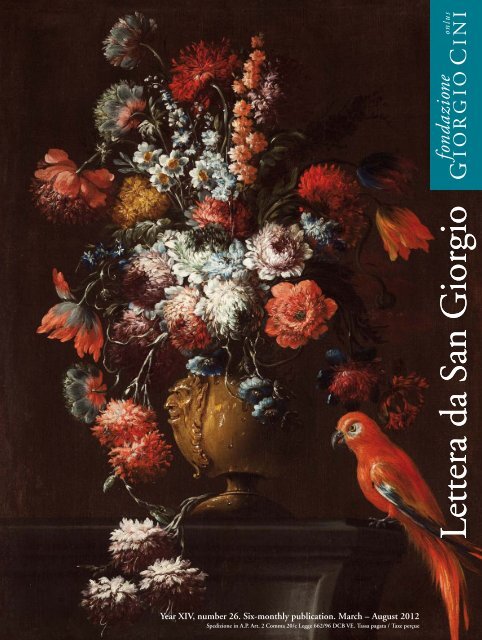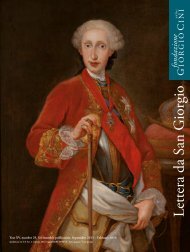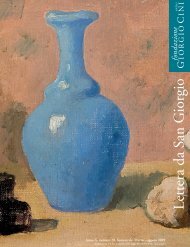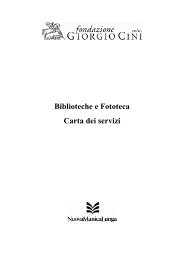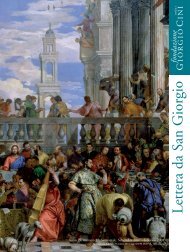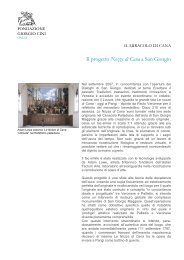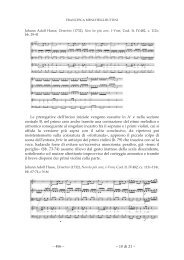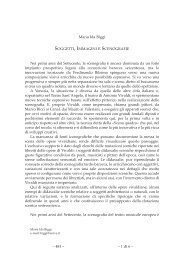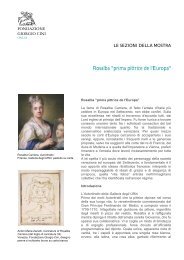Forthcoming Activities - Fondazione Giorgio Cini
Forthcoming Activities - Fondazione Giorgio Cini
Forthcoming Activities - Fondazione Giorgio Cini
Create successful ePaper yourself
Turn your PDF publications into a flip-book with our unique Google optimized e-Paper software.
Year XIV, number 26. Six-monthly publication. March – August 2012<br />
Spedizione in A.P. Art. 2 Comma 20/c Legge 662/96 DCB VE. Tassa pagata / Taxe perçue<br />
Lettera da San <strong>Giorgio</strong>
Programmes (March – August 2012)
i<br />
3<br />
4<br />
5<br />
6<br />
7<br />
7<br />
8<br />
8<br />
9<br />
10<br />
11<br />
11<br />
12<br />
12<br />
13<br />
14<br />
20<br />
22<br />
24<br />
iii<br />
Contents<br />
Programmes (March – August 2012)<br />
Editorial<br />
Main <strong>Forthcoming</strong> <strong>Activities</strong><br />
Nella Stanza di Eleonora Duse<br />
Play written and performed by Elena Bucci as part of the project “Women in Venice - creativity,<br />
economics and happiness”.<br />
RE: afRican: mix<br />
Connections and new practices in exploring African music<br />
The experience of Awesome Tapes from Africa and Sven Kacirek<br />
Round table with Sven Kacirek and awesome Tapes from africa plus marco Boccitto and<br />
Serena facci<br />
Live performance by Sven Kacirek and DJ set by awesome Tapes from africa<br />
meetings with chinese music<br />
Daoist music from Shanxi: popular rituals of the Li family, organised by Stephen Jones<br />
international conference<br />
Fashioning Opera and Musical Theatre: Stage Costumes in Europe from the Late Renaissance<br />
to 1900<br />
Intrecci e analogie tra vita e teatro d’arte<br />
Recital written and performed by maria Pia colonnello<br />
Palladio’s Refectory<br />
Public unveiling of the restoration work<br />
Books at San <strong>Giorgio</strong><br />
Bîrûn Ottoman music Workshops<br />
Composers at the Ottoman Court<br />
Exhibition<br />
Las Artes de Piranesi. Arquitecto, grabador, anticuario, vedutista y diseñador<br />
Historical Studies Seminar<br />
Bones in search of saints, saints in search of bones<br />
Egida Sartori and Laura alvini Early music Seminars<br />
Child soloists in Paris (1680-1720). Charpentier, Nivers, Clérambault, Campra<br />
international conference<br />
Portrait of a connoisseur: Tiziano Terzani<br />
international Summer School<br />
The Italian and European book civilization<br />
Performance of Wayang Kulit<br />
Javan Shadow Puppet Theatre<br />
Collections<br />
Still Lifes from the Vittorio <strong>Cini</strong> Collection<br />
Projects and Research<br />
Restoring Palladio’s Refectory<br />
Presences on San <strong>Giorgio</strong><br />
Andrea Palladio<br />
Publications<br />
Contacts
Editorial<br />
Over the last five years on several occasions the editorials of the Lettera da San <strong>Giorgio</strong> have<br />
dealt with the topic of the restoration and the functional redevelopment of the monuments<br />
and spaces on the island of San <strong>Giorgio</strong> maggiore. The completed projects include the<br />
installation of the facsimile of Veronese’s Wedding at Cana, the new Sale del convitto<br />
Exhibition centre, the nuova manica Lunga Library, the Vittore Branca international centre<br />
for the Study of italian culture and the Borges Labyrinth, officially opened on 14 June 2011.<br />
This year it’s the turn of Palladio’s Refectory, which has undergone a major restoration<br />
designed by michele De Lucchi and funded by the magistrato alle acque, Venice, and arcus.<br />
The restoration work, which will be unveiled to the public on 11 april, has involved the<br />
structural refurbishing of the interior, modernisation of the technological plants and the<br />
reintroduction of wainscoting to cover the lower parts of the refectory walls, plus new<br />
wooden flooring to match the wainscoting. in addition to recreating the original acoustics of<br />
the refectory, the restoration was also an opportunity to install new air conditioning and<br />
lighting systems. This project is typical of the care and commitment that we devote to the<br />
conservation and development of the heritage on the island of San <strong>Giorgio</strong> maggiore.<br />
among the many activities planned for the march-august 2012 semester, a completely new<br />
initiative for us deserves special mention: The Arts of Piranesi, first staged on San <strong>Giorgio</strong> in<br />
2010, has become an international travelling exhibition. The collection of engravings, all<br />
preserved in the <strong>Giorgio</strong> cini foundation, will now be shown to a Spanish public, first in<br />
madrid and then in Barcelona.<br />
Lastly, i should like to say that on 31 may and 1 June an international conference devoted to<br />
Tiziano Terzani will be held on San <strong>Giorgio</strong>. The conference will focus on the many facets of<br />
this major figure in italian culture, who was a writer, journalist, intellectual and explorer.<br />
Terzani’s private library has been donated by the family to the foundation and will enhance<br />
the library of the Study centre for comparative Studies of civilizations and Spirituality.<br />
This new centre has evolved naturally from the previous Venice and the East institute,<br />
which was founded in 1958 with the principal aim of promoting the study of the civilisations<br />
of india and the far East. Over the years it was a forum for continuous dialogue between East<br />
and West, between different peoples, civilisations and religions as well as a resource for<br />
scholars from all over the world, attracted by its remarkably rich library or its seminars,<br />
conferences and publications.<br />
5<br />
President<br />
Giovanni Bazoli
Eleonora Duse, c. 1910<br />
Main <strong>Forthcoming</strong> <strong>Activities</strong><br />
8 march 2012<br />
Nella Stanza di Eleonora Duse<br />
A play written and performed by Elena Bucci<br />
Sound drama by Raffaele Bassetti<br />
Lights by Giovanni Macis<br />
Venice, island of San <strong>Giorgio</strong> maggiore<br />
in 2011 the Study centre for Documentary Research into European Theatre and Opera<br />
opened the Stanza Duse, a permanent exhibition space dedicated to Eleonora Duse (for<br />
visits booking required). among events associated with the new space is Nella stanza di<br />
Eleonora Duse (“in Eleonora Duse’s Room”), a play written and performed by Elena<br />
Bucci. The text is based on Duse’s letters as well as critical writings about her.<br />
a director and actor who trained in the historic group of the Teatro di Leo de Bernardinis,<br />
Elena Bucci is also a playwright and currently head of the compagnia Le Belle<br />
Bandiere. for many years now she’s been writing plays around the figure of Eleonora<br />
Duse, whom she thinks is a wonderful companion: “as time goes by i gradually understand<br />
her in different ways and so my plays about her have changed with me. Every<br />
time they bring up new issues and new landfalls. This authentic woman with many<br />
facets was never afraid to explore and experience passions and feelings in depth. She<br />
translated them into highly-strung, imaginative writing that looks like a drawing or a<br />
stave of emotions.”<br />
The play will be staged in Longhena’s stunning Library in the <strong>Giorgio</strong> cini foundation<br />
at 5.30 pm on march 8. it is part of the series of events entitled “Women in Venice –<br />
creativity, economics happiness” (8-11 march), promoted by the city of Venice cultural<br />
activities Department.<br />
6<br />
Main forthcoMing activities
awesome Tapes from africa<br />
conferences, courses and exhibitions<br />
15 march 2012<br />
RE: AFRICAn: MIX<br />
Connections and new practices in exploring African music<br />
The experience of Awesome Tapes from Africa and<br />
Sven Kacirek<br />
Round table with Sven Kacirek and awesome Tapes from africa<br />
plus marco Boccitto and Serena facci<br />
Live performance by Sven Kacirek and DJ set by awesome Tapes from africa<br />
Venice, Teatro fondamenta nuove<br />
in the 20th century the coming together of musicians from different geographical<br />
areas and therefore with different musical backgrounds and sensibilities became an<br />
increasingly common feature at concerts and also in compositional practice. from the<br />
exotic and primitive forms of the early 20th-century we have now reached a situation<br />
of full-blown musical “bilingualism” and deep crossovers involving the study of theory<br />
and practice and the widespread circulation of music and musicians.<br />
Promoted jointly by the intercultural institute of comparative music Studies and the<br />
Teatro fondamenta nuove, this round table is aimed at stimulating thinking specifically<br />
on african music.<br />
arguably the continent that has most influenced 20th-century popular music (thanks mainly<br />
to the so-called music of the “african Diaspora”), africa continues to be a great workshop<br />
of ideas and repertories which often, however, remain outside the globalised media<br />
(including the web and its powerful commercial services, such as the iTune store).<br />
One of the guests at the Venetian meeting is Brian Shimkovitz, in art “awesome Tapes<br />
from africa”. On his trips to various african countries he has collected a huge number of<br />
music cassettes produced and sold locally. Through a web site, run with the approval of the<br />
musicians, and his DJ sessions, awesome Tapes from africa is promoting music from africa<br />
that otherwise would never be heard outside the continent (www.awesometapes.com).<br />
Sven Kacirek has a different approach. One of the most innovative contemporary German<br />
composers, he can be seen in a tradition of sophisticated crossovers between European<br />
and “exotic” music. This is a new form of exoticism consisting of direct encounters with<br />
village music, field recordings, and in this case also direct relations with the musicians<br />
(http://svenkacirek.de/).<br />
following on from the round table, awesome Tapes from africa and Sven Kacirek will<br />
be in concert at 9 pm on 15 march at the Teatro fondamenta nuove.<br />
7
The Li manshan Daoist Group from mount<br />
Hengshan<br />
25 - 27 march 2012<br />
Meetings with Chinese Music<br />
Daoist Music from Shanxi: popular rituals of the Li family,<br />
organised by Stephen Jones<br />
Venice, island of San <strong>Giorgio</strong> maggiore, Palazzo Vendramin dei carmini<br />
and auditorium Santa margherita<br />
in collaboration with the Department of Studies on asia and mediterranean africa,<br />
ca’ foscari University, Venice, and the confucius institutes of Venice, Turin, milan<br />
and Rome, the intercultural institute of comparative music Studies of the <strong>Giorgio</strong><br />
cini foundation has organised a third series of meetings dedicated to chinese music.<br />
They consist of two lectures to be given by Professor Stephen Jones, a leading expert on<br />
chinese folk music, at the Palazzo Vendramin dei carmini and two concerts to be<br />
performed by the Li manshan Daoist musicians at the <strong>Giorgio</strong> cini foundation and at<br />
the auditorium Santa margherita, Venice.<br />
The Daoist ensemble of the Li family from mount Hengshan in Shanxi Province is<br />
made up of wind instruments (oboe, free-reed mouth organ, shells) and percussion<br />
instruments (drums, cymbals and bells). During various rituals, they perform a<br />
repertory of sung hymns and instrumental music.<br />
This ensemble is a typical example of a ritual musical group from rural china. in this<br />
case Daoism is approached in a different way from the mysticism and meditation of the<br />
philosophical tradition found in the large urban temples. in the rural areas Daoism is<br />
mainly pursued by small family peasant groups specialised in the practical rites, handed<br />
down from father to son for generations as they work for the well-being of the community.<br />
These groups meet to communicate with the gods to ask for favours and to<br />
hand on, within the family group, complex ritual knowledge, manuscripts on how to<br />
perform rites, paintings, talismans and mantras. The musicians perform long ritual<br />
sequences over several days (2 to 4 days) to accompany temple festivities, festivals and<br />
rites to fulfil vows and in general to re-establish cosmic and social harmony. Ordering<br />
the cosmos through sad melodies (slow hymns) and comic tunes (mainly involving<br />
the wind instruments), the musicians contribute to fostering harmony in their rural<br />
communities through the healing force of ritual and music.<br />
The earliest mention of these Daoist musician-priests goes back to the Qing dynasty.<br />
albeit with several periods of deep crisis, the tradition seems to have survived uninterrupted<br />
even during the cultural Revolution, while in the 1980s there was a strong revival.<br />
8<br />
Main forthcoMing activities
anton maria Zanetti, Caricature of Nicola<br />
Grimaldi called Niccolino and Francesca Guzzoni,<br />
c. 1730 Venice, fondazione <strong>Giorgio</strong> cini<br />
Luigi cella, Eleonora Duse and her daughter<br />
Enrichetta, c. 1887, Venice, fondazione <strong>Giorgio</strong> cini<br />
conferences, courses and exhibitions<br />
29 march 2012 - 1 april 2012<br />
International conference<br />
Fashioning Opera and Musical Theatre: Stage Costumes in<br />
Europe from the Late Renaissance to 1900<br />
Venice, island of San <strong>Giorgio</strong> maggiore<br />
in collaboration with the University of Southampton and the Historical archives of<br />
the Rubelli Textile collection, the <strong>Giorgio</strong> cini foundation Study centre for Documentary<br />
Research into European Theatre and Opera has promoted an international<br />
conference on the history and role of costumes in musical theatre: Fashioning Opera<br />
and Musical Theatre: Stage Costumes in Europe from the Late Renaissance to 1900.<br />
Stage costumes play a key role in the way we experience musical theatre. They define<br />
the character and action, enhance the sound dimension and blur the boundaries between<br />
fact and fiction, past and present, and the human and the fantastic. from courtly theatre<br />
to popular entertainment, costumes, textiles and accessories are evidence of the material<br />
culture of their social milieus and the challenges that artists, craftsmen and designers<br />
faced in creating them. This conference brings together experts from various fields to<br />
discuss historical, economic and aesthetic issues related to the use and function of stage<br />
costumes in opera and musical entertainment in Europe from the late Renaissance to<br />
the early 20th century.<br />
The official conference languages are English and italian. The conference programme<br />
was drafted by a committee made up of the following experts: maria ida Biggi, isabella<br />
campagnol, Doretta Davanzo Poli, Valeria De Lucca and Helen Greenwald.<br />
5 april 2012<br />
Recital written and performed by Maria Pia Colonnello<br />
Intrecci e analogie tra vita e teatro d’arte<br />
Venice, island of San <strong>Giorgio</strong> maggiore<br />
as part of the events dedicated to the Stanza Duse, and in collaboration with the club<br />
UnEScO, at 5.00 pm on 5 april, the actress maria Pia colonello will pay homage to<br />
the art of Eleonora Duse in a recital, written and performed by herself, entitled Intrecci e<br />
analogie tra vita e teatro d’arte (“crossovers and analogies between life and drama”).<br />
The recital is based on Duse’s letters to her daughter Enrichetta and her correspondence<br />
with Luigi Pirandello. in 1916 the great italian playwright had written the play La vita<br />
che ti diedi (“The Life i Gave You”) in the hope that Duse would take the lead part;<br />
the play was only staged for the first time in 1923 and Duse never performed in it.<br />
9
Rendering of Palladio’s Refectory<br />
LSG<br />
Libri a San <strong>Giorgio</strong><br />
11 april 2012<br />
Palladio’s Refectory<br />
Public unveiling of the restoration work<br />
Venice, island of San <strong>Giorgio</strong> maggiore<br />
after having been closed for a year for major structural and functional restoration<br />
work, Palladio’s Refectory with Paolo Veronese’s Wedding at Cana facsimile is once<br />
more open for public use. architect michele De Lucchi’s refurbishing project for the<br />
refectory involved various important operations: the renovation of the roof, which<br />
required urgent repair work; the modernisation of the air-conditioning and lighting<br />
plants and equipment; the introduction of up-to-date security equipment; and the installation<br />
of wooden panelling on the interior walls and floors to restore the acoustic<br />
and aesthetic function of the old wainscoting, which had been removed during the<br />
various uses of the island of San <strong>Giorgio</strong> before Vittorio cini’s redevelopment programme<br />
in the 1950s.<br />
The restoration work on Palladio’s Refectory was funded by the magistrato alle acque,<br />
Venice, and arcus.<br />
12, 19 april, 3 may 2012<br />
Books at San <strong>Giorgio</strong><br />
Venice, island of San <strong>Giorgio</strong> maggiore<br />
The yearly series begun in 2005 and now into its seventh year will resume again in april<br />
with the launch of the latest publications associated with the <strong>Giorgio</strong> cini foundation.<br />
The first book in the new crop of publications will be presented on 12 april: La Visione,<br />
the eighth volume in the “Viridarium” series brings together around ten essays on<br />
visionary experiences of authors or found in works of different ages and cultures, from<br />
a mediaeval christian to an Eastern Sufi and the interior worlds of 20th-century intellectuals<br />
like carl Gustav Jung and mark Rothko. On 19 april the featured book is a<br />
cini collection catalogue: Donato Creti. I disegni della raccolta Certani alla <strong>Fondazione</strong><br />
<strong>Giorgio</strong> <strong>Cini</strong> edited by marco Riccòmini. The launch will be accompanied by a temporary<br />
exhibition of some drawings from the certani collection, the subject of the book.<br />
Donato creti (1671-1749) enjoyed a very long and industrious career as a painter, fresco<br />
artist and above all, draughtsman. The artist was praised for his extraordinary skill in<br />
drawing so much that his graphic works were collected throughout Europe.<br />
Lastly, on 3 may the series ends by commemorating Giovanni morelli with the presentation<br />
of the latest issue of the magazine AAM-TAC Art & Artifacts in Movie, Technology,<br />
Aesthetics and Communication, a publication devoted to music and film.<br />
10<br />
Main forthcoMing activities
music at the Ottoman court. miniature by<br />
Levni from Surname-i Vehbi, 1720-1725<br />
conferences, courses and exhibitions<br />
16 april - 21 april 2012<br />
Bîrûn Ottoman Music Workshops<br />
Composers at the Ottoman Court<br />
Venice, island of San <strong>Giorgio</strong> maggiore<br />
The intercultural institute of comparative music Studies (iiSmc) at the <strong>Giorgio</strong> cini<br />
foundation will launch a new programme in 2012: the Bîrûn advanced Workshops on<br />
Ottoman classical music. The workshops are intended for musicians and musicologists<br />
who wish to further their instrumental and musicological knowledge in this important<br />
field of traditional music. The teacher as well as artistic and cultural director of the<br />
advanced workshops is Kudsi Erguner, an internationally-renowned musician and<br />
music o logist who, for several years now, has been teaching courses of ney flute at the<br />
iiSmc, assisted by the ethnomusicologist Giovanni De Zorzi, an expert on traditional<br />
music for the area in question. as part of this project, which will run for several years,<br />
the institute has announced that six scholarships are available for professional or semiprofessional<br />
musicians specialised in Ottoman classical music, or wishing to explore<br />
the tradition further. The aim of the scholarships is to form a musical ensemble which<br />
will focus on some specific aspects of Ottoman classical music (repertoires, composers<br />
and manuscripts) chosen by Kudsi Erguner and Giovanni De Zorzi. The scholarship<br />
consists of hospitality on the island of San <strong>Giorgio</strong>, payment of travelling expenses and<br />
the possibility to enjoy the new opportunities offered by the Vittore Branca center and<br />
its recently opened Residence at the <strong>Giorgio</strong> cini foundation.<br />
The first workshop will be devoted to the study of pieces by composers from various<br />
religious and ethnic communities in the Ottoman Empire (Turkish, Greek, Jewish,<br />
armenian and even italian) and in various historical periods (from the 17th to the 20th<br />
century) with the aim of highlighting the multiethnic, multicultural character of the<br />
Ottoman music tradition throughout its history. at the end of the workshop there will<br />
be a public concert in which the participants will perform some pieces studied during<br />
the workshop. The name of the workshops – Bîrûn – has been inspired by the outer<br />
court at the Topkapi palace in istanbul. after the Ottoman capture of constantinople in<br />
1453, the Sultan mehmet ii, known as “fatih the conqueror”, began construction of<br />
the imperial Palace in 1465. This building then became known as the Saray (from the<br />
arabic sarây, “palace”, see also mozart’s “seraglio”) or Bâb-i ‘ali, the “Sublime Porte” which<br />
for centuries was the sultans’ favourite residence and the centre of Ottoman artistic and<br />
cultural life. The Saray was divided into an outer part and an inner part and this architectural<br />
division is reflected in its institutions: the Bîrûn-i Hümâyûn administered life<br />
in the outer court, while the Enderûn-i Hümâyûn dealt with life in the inner court of<br />
the palace, which included the throne room, harem and sultan’s private apartments. in<br />
both sections there was a mekteb palace school which provided musical education, as<br />
well as teaching poetry, calligraphy and the art of the miniature – those fine arts that<br />
made the Ottoman world so famous.<br />
11
The project for an advanced course of Ottoman classical music at the <strong>Giorgio</strong> cini<br />
foundation was thus inspired by the idea of the Birûn, the outer palace school that<br />
although external was close to the heart of Ottoman culture, just as Venice was a kind<br />
of European outer court on the grounds of its thousand-year relations with Byzantium/<br />
constantinople/istanbul.<br />
25 april- 9 September 2012<br />
Exhibition<br />
Las Artes de Piranesi. Arquitecto, grabador, anticuario,<br />
vedutista y diseñador<br />
madrid, caixa forum<br />
The exhibition entitled The Arts of Piranesi. Architect, printmaker, antiquarian, vedutista,<br />
designer, conceived by architect michele De Lucchi and produced by the <strong>Giorgio</strong> cini<br />
foundation and adam Lowe’s factum arte studio was held in the Sale del convitto<br />
exhibition centre on the island of San <strong>Giorgio</strong> maggiore in 2010. Thanks to a twoyear<br />
agreement with the caixa foundation, Barcelona, the exhibition will now also be<br />
staged in madrid (25 april – 9 September 2012) and Barcelona (9 October 2012 – 6<br />
January 2013).<br />
The exhibition explores the many and varied activities of Giambattista Piranesi (Venice<br />
1720 – Rome 1778), one of the most fascinating and complex figures in 18th-century art.<br />
The spell-binding exhibition itinerary features prints selected from the complete works<br />
held in the <strong>Giorgio</strong> cini foundation graphic collections and a series of ad hoc creations<br />
embodying Piranesi’s language, style and natural flair for crossing over ancient and<br />
modern formal repertories in ingenious combinations.<br />
The Arts of Piranesi is a pioneering and thought-provoking exhibition, exactly in the<br />
spirit of Piranesi himself. it has been designed to highlight the polymath interests, style<br />
and remarkable modernity of the Venetian artist, also through the presence of a number<br />
of contemporary works inspired by his work, such as a 3D film of the Carceri d’Invenzione<br />
made by factum arte and eight original objects created by starting from Piranesi<br />
prints (two tripods, a vase, a chair, a candelabrum, an altar, a coffee pot and a stunning<br />
fireplace complete with fire furniture). The exhibition also features thirty-two views of<br />
Rome by Gabriele Basilico, a photographer’s personal homage to the great artist.<br />
12<br />
Main forthcoMing activities
Vittore carpaccio, Miracle of the True Cross at<br />
Rialto, Venice, Gallerie dell’accademia<br />
conferences, courses and exhibitions<br />
7 - 9 may 2012<br />
Historical Studies Seminar<br />
Bones in search of saints, saints in search of bones<br />
Venice, island of San <strong>Giorgio</strong> maggiore<br />
as usual, the annual Historical Studies Seminar, held by the institute for the History<br />
of the Venetian State and Society, will consist of five round tables spread over two and<br />
a half days. This year’s seminar is entitled “Bones in search of saints, saints in search of<br />
bones”. in theory the discussion topics will not only be limited to relics of saints as such<br />
(e.g. those inventoried in the treasure of San marco in St mark’s cathedral) but may be<br />
broadened to take in the “sanctification” of sung and unsung heroes of the Risorgimento<br />
and post-Risorgimento as well as ossuaries and memorials erected after the first World<br />
War.<br />
23 - 29 may 2012<br />
Egida Sartori and Laura Alvini Early Music Seminars<br />
Child soloists in Paris (1680-1720). Charpentier, Nivers,<br />
Clérambault, Campra<br />
Venice, island of San <strong>Giorgio</strong> maggiore<br />
This year’s early music seminar will explore a repertory that is as unusual as it is neglected:<br />
music for child soloists in Paris in the late 17th and early 18th centuries. The repertoire<br />
flourished above all in choirs and ensembles in the various churches and convents in the<br />
city (especially the Sainte chapelle and the monastery of Port Royal) as well as in Jesuit<br />
and other religious schools in general. music was composed to be performed by child<br />
soloists in other places too, however: opera houses, theatres, lay musical schools frequented<br />
by the children of the lower nobility and the drawing rooms of the courts of<br />
Paris and Versailles. The principal composers in the repertoire include charpentier,<br />
Bernier, nivers, clérambault and campra. charpentier composed a number of works<br />
with children as lead singers, such as David and Jonas, performed for the first time in<br />
the Jesuit college of Louis-le-Grand in 1688. nivers and clérambault composed motets<br />
for the “Demoiselles de Saint-cyr”, the female students in a school founded in 1686.<br />
The repertoire raises a number of music-history and aesthetic issues, but also socialhistory<br />
and moral questions. The music ranges from neo-Gregorian works to religious<br />
plays and simplified versions of operas and oratorios or chansons with arcadian and love<br />
texts. The presumed unwitting condition (or at least only partial awareness) of the<br />
child singers may have contributed to the success of the phenomenon in court circles.<br />
moreover, this aspect may also have contributed to the association of child soloists –<br />
unknowing vehicles for messages – with the Kircherian myth of the automaton in music.<br />
13
Tiziano Terzani on an initial trip to china in 1979,<br />
© archivio Terzani<br />
These issues still inform the activities of today’s musicologist, directors and teachers<br />
interested in reviving the refined art of the child soloists – singers but also instrumentalists<br />
or composers, for example, in 18th-century Paris – and presenting it to modern<br />
audiences. There are various kinds of obstacles to be overcome, however, and they<br />
require specialist reflection and, most importantly, multidisciplinary exchanges.<br />
The guests at the seminar will include some child soloists from the celebrated choir Les<br />
Pages du Centre de Musique Baroque de Versailles and international singers, teachers and<br />
musicologists, including Sophie Daneman, Davitt moroney and Hélène Petrossian.<br />
31may - 1 June 2012<br />
International conference<br />
Portrait of a connoisseur: Tiziano Terzani<br />
Venice, island of San <strong>Giorgio</strong> maggiore<br />
This conference has a twofold aim: on one hand to celebrate the donation to the <strong>Giorgio</strong><br />
cini foundation of Tiziano Terzani’s personal library by his widow angela Staude<br />
Terzani and, on the other, to unveil the Study centre for comparative Studies of<br />
civilisations and Spirituality. The new centre will adopt a comparative and intercultural<br />
approach with a special emphasis on religious and spiritual dimensions of the civilisations<br />
being studied and compared. it will also have a broader outlook to take in the most<br />
important spiritual traditions in the world and not only Oriental ones.<br />
The conference organised by Àlen Loreti will explore all aspects of the complex, manysided<br />
figure of Tiziano Terzani with the aim of arriving at a portrait free of the kinds of<br />
prejudices and clichés that have previously clouded discussion on this writer, journalist<br />
and major figure in contemporary italian culture (mondadori have recently published<br />
his complete works in the “meridiani” series).<br />
5 - 14 June 2012<br />
International Summer School<br />
The Italian and European book civilization<br />
Venice, island of San <strong>Giorgio</strong> maggiore<br />
The European Research centre on Books, Publishing, Libraries (cRELEB) at the<br />
Università cattolica del Sacro cuore, milan, in collaboration with the <strong>Giorgio</strong> cini<br />
foundation and aiB – associazione italiana Biblioteche, is promoting the first edition<br />
of an international summer school devoted to the italian and European antique book<br />
culture, due to be held on the island of San <strong>Giorgio</strong> maggiore from 5 to 14 June.<br />
Directed by Professor Edoardo Barbieri of the Università cattolica del Sacro cuore,<br />
milan, the summer school is addressed to graduates and Ph.D. students, bibliography and<br />
14<br />
Main forthcoMing activities
andrea corvo, Chiromancy, Venice 1518<br />
Wayang-purwa puppet of Bima, one of the five<br />
Pandawa brothers in the Mahabharata (Java)<br />
conferences, courses and exhibitions<br />
graphic arts scholars, collectors and antiquarians with an interest in the history of italian<br />
and European books in the age of manual printing, i.e. from the 15th to the 18th century.<br />
Various topics will be addressed: the production of printed books; the history of publishing<br />
and bookselling; book illustrations and binding; the relationship between books<br />
and literary, religious and artistic culture; a history of collecting and bibliography; and<br />
descriptive and catalographic issues. Held in italian, french, English and Spanish, lessons<br />
will be alternated with workshops and study tours of Venetian library and documentary<br />
collections.<br />
invited experts include ilaria andreoli (Villa i Tatti), James clough (Politecnico di<br />
milano), françois Dupuigrenet Desroussilles (florida State University), francesco<br />
malaguzzi (editor of Bibliofilia Subalpina), Elisa Ruiz Garcia (Universidad complutense,<br />
madrid), Giancarlo Petrella (Università cattolica, milan), Gilberto Pizzamiglio<br />
(<strong>Giorgio</strong> cini foundation), marielisa Rossi (Università di Roma Tor Vergata) and<br />
Lucia Sardo (<strong>Giorgio</strong> cini foundation).<br />
12 June 2012<br />
Performance of Wayang Kulit<br />
Javan Shadow Puppet Theatre<br />
Venice, Teatro Goldoni<br />
On 12 June at the Teatro Goldoni, a performance of Javan shadow puppet theatre<br />
(wayang kulit), will be given by artists from the Yogyakarta iSi, one of most prestigious<br />
music and dance academies created by the indonesian government to promote the teaching<br />
and spread of traditional arts. This show has been organised by the intercultural institute<br />
of comparative music Studies at the <strong>Giorgio</strong> cini foundation in collaboration<br />
with the indonesian ministry of Education, the indonesian Embassy to the Holy See,<br />
the city of Venice and the music for Rome foundation and under the patronage of the<br />
Patriarchate of Venice Offices for the cultural Heritage and Tourism. The event takes on<br />
even greater importance considering that Javan puppet theatre, one of the most refined<br />
art forms in indonesia, has not been performed in italy for such a long time.<br />
Wayang kulit (literally “leather theatre”) is usually performed at public festivities and<br />
religious celebrations. On Java it is the main aesthetic reference model for music, words,<br />
painting and gestures, which are all then combined in the performance. The characters<br />
are represented by various figures, which have been cut out of leather and then delicately<br />
decorated. The puppets are manoeuvred to project shadows on an illuminated screen.<br />
There is only one puppet master known as the dalang who moves and provides the<br />
voice for a very large number of characters. The play is accompanied by the sound of<br />
the gamelan orchestra whose role is to underscore all the dramatic movements during<br />
the performance by expressing through song and musical instruments of various kinds<br />
the emotions, feelings and moods of the characters who act on the lit-up canvas screen.<br />
15
a. Sangiovanni, Vase of Flowers with Parrot.<br />
Venice, fondazione <strong>Giorgio</strong> cini<br />
Collections<br />
Still Lifes from the Vittorio <strong>Cini</strong> Collection<br />
Of the activities pursued annually by the <strong>Giorgio</strong> cini foundation, those concerning the<br />
protection and conservation of its own art collections is particularly important. at present<br />
ongoing restoration work concerns a large number of paintings and sculptures kept in<br />
the rooms of the former abbot’s apartment in the monastery of San <strong>Giorgio</strong>. a redevelopment<br />
programme involving firstly the architectural structure, then the technical installations<br />
and window and door frames will be completed by a plan to showcase the art<br />
works through a more effective and logical distribution in the board and reception rooms.<br />
among the works, three still life paintings stand out for their quality and uniformity.<br />
Having come from a larger collection of the genre once owned by count Vittorio cini,<br />
they are now fully legible again thanks to the conservational and aesthetic restoration<br />
work conducted by claudia Vittori and annamaria D’Ottavi. This work provided the<br />
opportunity for a more in-depth technical examination and a re-assessment of the works’<br />
history and attribution.<br />
Of the three works, the pair of 18th-century paintings with vases and floral bouquets came<br />
from the Palazzo cini at San Vio. Vittorio cini acquired them from Roseo in Rome in<br />
1942, as is revealed by the handwritten general inventory for the collection, whose numbers<br />
have corresponding numbers on the labels on the frames. Thanks to the inventory<br />
register of the foundation’s possessions, we can circumscribe the period when the two<br />
still lifes passed from Palazzo San Vio to the monastery of San <strong>Giorgio</strong>. in fact, they<br />
became part of the foundation’s art collections sometime between 1953 and 1954.<br />
The various flower species – daffodils, carnations, tulips, double anemones and Boule de<br />
neige white roses – are centrifugally arranged in elegant gilded bronze vases, decorated by<br />
ornamental patterns with a mannerist influence (grotesque mascarons and a plant-form<br />
handle in one of the paintings). On the reflecting surface, drops of water shine in the<br />
light, endowing the work with a sense of the instant and the freshness of the recently cut<br />
still tremulous flowers. On the edge of the shelf sit a canary and a parrot, respectively<br />
(part of the parrot’s tail has been brought to life again from under rough fill). The uniform<br />
dark background effectively heightens the plastic opalescence of the vases and the material<br />
feel of the flowers rendered by thick brushwork, thus creating a striking trompe-l’oeil<br />
effect, underscored by the two birds perched on the sharp edges of the shelves.<br />
Traditionally attributed to the flower-piece painter, Elisabetta marchioni, who was active<br />
in Rovigo in the second half of the 17th century (the reference was found in the index<br />
card in the photographic archive), the paintings were in an altered, darkened condition<br />
as regards the perception of the colour harmonies because of surface deposits of dust,<br />
16<br />
collections
a. Sangiovanni, Vase of Flowers with Goldfinch.<br />
Venice, fondazione <strong>Giorgio</strong> cini<br />
still lifes<br />
yellowing varnish and decayed retouching. considerable filling in and repainting with<br />
tempera during the previous antiquarian restoration extended to the side areas and the<br />
bottom, where it was applied over the original paint, thus also covering the painter’s<br />
signature. Both paintings are signed on the moulding on the shelf, as has been revealed<br />
by cleaning. The full surname is found in the painting with the parrot – “a. Sangiovanni<br />
P.” – but is incomplete because of abrasions and flaking in the second painting. Only<br />
three letters are still visible: “a. S […] P.” Sangiovanni was a still life painter – the surname<br />
suggests a neapolitan origin – and we know of another two pairs of paintings, also signed,<br />
previously in the Baratti collection in naples (the unknown measurements of the former<br />
Baratti paintings, if found, could corroborate this theory). They echo the iconography<br />
and the composition of the cini pair so much as to suggest they were part of the same<br />
series, probably conceived for a neapolitan patrician home. One of the paintings in the<br />
private collection bears the date “1716”. This is the only chronological reference found so<br />
far for this little-known flower-piece artist. On the grounds of similarities in composition,<br />
however, the dates can also be associated with the cini pair (a. Tecce, in La natura morta<br />
in Italia, edited by f. Porzio, ii, milan 1989, p. 947).<br />
another painting with a luxuriant arrangement of fruit, flowers and animals appeared<br />
on the antiquarian market with Sangiovanni’s signature added onto the verso. This is<br />
thus an addition to the artist’s meagre catalogue, corroborated in a written communication<br />
by mina Gregori, although at first glance and judging from the photograph, the paint<br />
would seem to be more uncertain in terms of enduring quality (farsettiarte, 13 november<br />
2004, lot 722).<br />
Sangiovanni’s artistic background is difficult to describe because of the very few surviving<br />
works. He would seem to have belonged to the group of neapolitan genre painters active<br />
in the late 17th and early 18th centuries. Here and there we find echoes of the use of<br />
paint by nicola casissa (? -naples 1731), who skilfully translated Giordano’s manner<br />
into genre painting and whose activity has recently been reassessed, despite Raffaello<br />
causa’s harsh criticism (La natura morte a Napoli nel Sei e Settecento, naples 1972, p.<br />
1054) of his “luminous decorativism” of Rococo origin. Some points of contact can also<br />
be found with a further two flower-piece specialists. The first is Gaspare Lopez (naples<br />
? - florence or Venice c. 1732.), whose presumed florentine activity and affinities with<br />
the still life painter andrea Scacciati (florence 1642-1710) may explain the Tuscan<br />
influences found by maurizio marini in Sangiovanni’s work (Nature morte italiane e<br />
italianizzanti del XVII secolo, exhibition catalogue edited by m. marini, Palermo 1984,<br />
cat. 34). and the second is francesco Lavagna, who was active in naples in the 17th<br />
century and documented though a number of signed works. many of his compositions<br />
are similar to the San giovanni paintings on the grounds of the arrangement of the flowers<br />
and the shape of the vases, but differ because of much thinner and fragmented brushwork<br />
and light-coloured backgrounds with landscape inserts.<br />
consolidation work to repair lifting and cleavage was conducted with acetone and ligroin<br />
by means of a compress (for the tempera retouching, a surfactant in a water solution was<br />
17
circle of Giovanni Battista Ruoppolo,<br />
Still Life of Fruit and Flowers. Venice,<br />
fondazione <strong>Giorgio</strong> cini<br />
applied several times). This made the paint fully legible once more. Optical microscope<br />
analysis highlighted the presence of glazes made from shell gold, probably mixed with a<br />
protein binder, applied over the yellow colour used for the parts in the light on the vases,<br />
which is thus given a gilded luminescent effect. The painter used the same medium for<br />
his signature painted directly on the last layer of colour on the plinths. Today it is clearly<br />
worn down due to mechanical abrasions caused by covering up the signature (the red clay<br />
ground preparation behind is still visible). The removal of the signature may have been<br />
carried out during an earlier antiquarian restoration with the aim of making the two<br />
paintings more attractive to the market, since they could be presented with a more highly<br />
rated attribution.<br />
The third significant <strong>Giorgio</strong> cini foundation still life painting can also be attributed to the<br />
neapolitan school. characterised by splendid craftsmanship and remarkable pictorial<br />
quality, the Still Life of Fruit and Flowers, a large display with an almost random arrangement,<br />
was also once in the Vittorio cini art collection. The left of the painting is<br />
occupied by a wicker basket full of black and white grapes. The bunches rise up on a<br />
bamboo cane, offering the juicy grapes to the onlooker’s eyes and connecting up with<br />
the embroidery of withered leaves and flowers. On the right, an overturned wide-meshed<br />
chestnut-wood basket spills out quince pears, peaches, cherries, plums and figs (a superbly<br />
executed mimesis of the split fig motif shows the reddish pulp, while the film of dust on<br />
the plums’ skins is also visible). The foreground is dominated by a half watermelon of a<br />
rich vermillion colour and a large pumpkin, set beside pears and little roses.<br />
18 collections
Giuseppe Recco, Still Life of Tableware, Fruit<br />
and Tuna Steak. formerly Venice, collezione<br />
Vittorio cini<br />
Giovanni Battista Ruoppolo (?), Still Life of Fruit<br />
and Thistle. Venice, fondazione <strong>Giorgio</strong> cini<br />
still lifes<br />
The restoration involved consolidation work (the pictorial surface suffered from severe<br />
lifting) and cleaning with acetone, which removed the colour from crude retouching as well<br />
as dirt deposits. Other operations included a biocide treatment on the retro, stretching,<br />
the application of perimeter bands to re-mount the painting on the frame and varnishing.<br />
at present the final stage of refilling and mimetic retouching is being completed.<br />
consulting the handwritten inventory for the Vittorio cini collection in search of<br />
information about the acquisition is of no help, while the photographic index card in<br />
the foundation archives bears the inventory number and the attribution, which we accept<br />
with reservations as being to the painter Giovanni Battista Ruoppolo (naples 1629-<br />
1693), one of the leading painters of neapolitan still life in the second half of the 17th<br />
century. This is not the place to venture into the intricacies of the Ruoppolo school,<br />
which includes many high-standard artists, such as Giuseppe Ruoppolo (naples ?-1710),<br />
who has been attributed with paintings bearing the monogram “GRV”; or the less wellknown<br />
members of the family, such as Gaetano Luciano, Lionelli and aniello ascione.<br />
The quality of the cini painting, which has moments of fresh realism and very careful<br />
brushwork in the fruit in full light, would effectively suggest an autograph work by<br />
Giovanni Ruoppolo, although, among other things, we have to consider paint that has<br />
deteriorated greatly. at the same time, the compositional models and the iconographic<br />
details are closer to the work of Giuseppe at his best. Pending authoritative opinions, we<br />
can conveniently maintain the attribution to the circle of Giovanni Battista.<br />
This painting belongs to a group of works ascribed to the neapolitan school that was<br />
acquired by cini and handed onto his heirs: in particular the quality of a Still Life of<br />
Fruit and Thistle, brings it close to the early stage of Ruoppolo, with some echoes of the<br />
anonymous maestro della floridiana and in his wake the late works of Luca forte (naples<br />
c. 1600/1605-before 1670): see for example the twisting leaves of the vine branches<br />
and grapes. The same can be said of a splendid Still Life of Tableware, Fruit and Tuna<br />
Steak, once in the salone d’onore in monselice castle, ascribed by Berenson to Diego<br />
Velázquez and then correctly attributed by Zeri to the young Giuseppe Recco (naples<br />
1634 - alicante 1695).<br />
19
michelangelo Pace di campidoglio, Still Life of<br />
Fruit Basket and Monkey. formerly Venice,<br />
collezione Vittorio cini<br />
abraham Brueghel (?), Vase of Flowers with<br />
Plums and Peaches. formerly Venice, collezione<br />
Vittorio cini<br />
Giovanni Paolo castelli called Spadino, Still Life<br />
of Fruit and Rabbits. formerly Venice, collezione<br />
Vittorio cini<br />
another two paintings in the group – Still Life of Fig Bowl and Still Life of Apples, Grapes<br />
and Peaches – are indicated in the handwritten inventory of the Vittorio cini collection<br />
(with the numbers 5442 and 5443) as being by Ruoppolo. They can be more accurately<br />
assigned to the circle of michelangelo cerquozzi (Rome 1602-1660).<br />
incidentally, in the group handed down to the heirs there were other still life paintings<br />
by Roman artists, such as michelangelo Pace di campidoglio (Rome 1610?-1670?),<br />
attributed with the Still Life of Fruit Basket and Monkey, or the anonymous Roman<br />
genre painter with a cerquozzi background, active from the mid-17th century. a corpus<br />
for this artist’s works has been constructed thanks to the unusual shape of the broad<br />
wicker basket full of fruit, which is identical to the basket in the cini Still Life of<br />
Fruit Basket.<br />
in the cini collection there are also three paintings that can be associated with the work<br />
of the antwerp artist abraham Brueghel (antwerp 1631-naples 1697). He was one of<br />
the most important Baroque-age still life painters active in Rome – where he skilfully<br />
combined his flemish training with the post-caravaggio culture of cerquozzi and Pace<br />
– and in naples, where he probably settled in 1676 and where his sumptuous inventions<br />
catered for the taste of his neapolitan patrons. His works thus dialogued closely with the<br />
paintings of Paolo Porpora, the Recco and the Ruoppolo. The three paintings in question<br />
are a Vase of Flowers with Plums and Peaches, attributable to his Roman period, and a<br />
matching pair of two horizontal compositions with fruit and flowers.<br />
Lastly, i would also mention a pair of 18th-century paintings, a Still Life of Fruit and<br />
Parrot and a Still Life of Fruit and Rabbits, documented in the photographic archive as<br />
being by Baldassarre de caro (? 1689-naples 1750), but actually more similar in style<br />
and composition to the work of Giovanni Paolo castelli called lo Spadino (Rome 1659c.1730)<br />
on the grounds of the dissolved impasto, the settings in evanescent gardens only<br />
just hinted at by vegetable patterns and the presence of pets; these elements are derived<br />
from the compositions of the more skilful German still life artist franz Werner Tamm<br />
called Daprait (Hamburg 1658-Vienna 1724).<br />
The group of still life paintings that came from the Vittorio cini collection were further<br />
complemented by two works that the foundation acquired directly from acerbi in 1954<br />
as being by the neapolitan school: a Still Life of Bunches of Grapes in a Wicker Basket and<br />
Birds and a Still Life of Bunches of Grapes in a Vat, Mushrooms and Parakeets. Both these<br />
works can be ascribed to the circle of the modena painter francesco malagoli, active in<br />
the 18th-century and mentioned in the sources as particularly skilful at simulating grapes<br />
“so true as to deceive anyone” (marcello Oretti, Cronica o sia Diario Pittorico, Bologna,<br />
Biblioteca comunale, mS B 106). malagoli’s authorship shows through in some morellilike<br />
details, such as the leaves on the vine branches riddled with holes in the foreground,<br />
sketched in the shade. They are found both in the paintings being examined here and in<br />
another work in the Vittorio cini collection, which did not come into the foundation<br />
collections, but is a certain autograph work and perfectly echoes the other two paintings<br />
20<br />
collections
francesco malagoli, Still Life of Bunches of Grapes.<br />
formerly Venice, collezione Vittorio cini<br />
francesco malagoli, Still Life of Bunches of Grapes in a Wicker Basket and Birds.<br />
Venice, fondazione <strong>Giorgio</strong> cini<br />
still lifes<br />
now in the Bologna city art collections (D. Biagi maino in La natura morta in Italia,<br />
edited by f. Porzio, i, milan 1989, pp. 434-435).<br />
another pair of paintings similar to the cini pair on the grounds of their subject<br />
and composition – also ascribed to the circle of malagoli, who was active in modena,<br />
Bologna and mantua – is held by the heirs of the ferrara collector antonio Santini<br />
(1824-1898; L. Scardino, La collezione d’arte di Antonio Santini (ferrara 1824-1898),<br />
ferrara 2004, p. 222).<br />
21<br />
Alessandro Martoni<br />
francesco malagoli, Still Life of Bunches of Grapes in a Vat, Mushrooms and<br />
Parakeets. Venice, fondazione <strong>Giorgio</strong> cini
Rendering of Palladio’s Refectory<br />
Projects and Research<br />
Restoring Palladio’s Refectory<br />
in the monumental complex on the island of San <strong>Giorgio</strong> maggiore, the large monastery<br />
refectory was designed by andrea Palladio as part of the general remodelling of the<br />
buildings in the first cloister and the basilica of San <strong>Giorgio</strong>. Undoubtedly one of the<br />
most striking and beautiful structures in the complex, the refectory was the largest nonsacred<br />
building constructed by Palladio in his career. The interior was subsequently<br />
complemented by Paolo Veronese’s large painting of the Wedding at Cana, specially<br />
commissioned for the rear wall.<br />
Large-scale restoration works, also involving the refectory, were conducted on the island<br />
of San <strong>Giorgio</strong> in the 1950s, under the direction of the architect forlati as part of the<br />
ambitious redevelopment project for the island conceived and completed by count cini.<br />
in further redevelopment work begun in 2001 the refectory building was only slightly<br />
affected, pending the latest project finally aimed at restoring the original splendour to<br />
the building almost 60 years after the 1953 restoration.<br />
The project was finally drafted in 2009-2010 on the basis of an idea by the architect<br />
michele De Lucchi, who had just completed the restoration of Buora’s manica Lunga,<br />
the “Long Sleeve” or grand corridor of the monastery, now the large new cini foundation<br />
library.<br />
The basic idea in the refectory project was to restore the original wainscoting on the walls<br />
that formed the backs of the benches, where the monks once sat when eating their meals<br />
in the refectory. This meant giving up the idea of reconstructing the friezes, mouldings<br />
and bas reliefs once on the Renaissance benches in favour of modern-style, essential<br />
wooden panelling, made of very high-quality wood and decorated with intarsia. To<br />
complete the harmonious arrangement of the geometric elements and the vistas, a further<br />
binding element was required. De Lucchi achieved this by introducing a new wooden<br />
floor echoing the patterns created by the various wooden elements in the panelling. The<br />
flooring thus also dialogues with the vertical walls generating an overall play of lines and<br />
surfaces whose rhythm is set by juxtapositions and contrasts between walnut and oak.<br />
The intense, innovative project was designed to include indispensable maintenance<br />
work, consisting of three different basic operations. firstly, the renovation of the tiled<br />
pitched roof, which required urgent work, such as the consolidation and restoration of<br />
numerous sections of both the primary and secondary beams as well as the complete<br />
replacement of the tiles covering the roof. Various other associated operations were<br />
required such as cleaning, plastering and sealing the istrian stone eaves, pipes and drains,<br />
while damaged brackets had to be repaired as did the air vents in the attic. a plan was<br />
22 Projects and research
Sketch by michele De Lucchi<br />
restoring Palladio’s refectory<br />
prepared for structural work on the parts of the floor separating the great hall from the<br />
basement, which was in a fairly serious state of disrepair.<br />
The second major operation concerned the technical plants and equipment which dated<br />
to 1950s: i.e. the underfloor heating, a single inefficient, noisy obtrusive closet airconditioner<br />
in the great hall and inadequate electrical wiring and lighting. a plan for the<br />
complete renewal of all the technical equipment and plants was prepared for the electric<br />
systems, fire prevention, water heating, telephone and data-transmission system, lighting<br />
and air conditioning.<br />
The project included the use of the basement beneath the large main hall of the refectory<br />
for the technical plants and piping, thus reducing to a minimum any work within the<br />
hall itself.<br />
The security equipment (fire prevention devices, emergency lights and burglar alarms)<br />
was designed to bring the refectory building up to the highest security standards required<br />
by italian law and in any case necessary to protect such an important historic architectural<br />
landmark.<br />
The third operation, as mentioned earlier, consisted of installing wooden panelling to<br />
restore in an historically accurate way the benches along the whole lower part of the<br />
refectory wall and so also integrate it with the new wooden flooring according to the<br />
design idea provided by De Lucchi, who also supervised the construction of a scale model<br />
and sample panelling.<br />
Thanks to the delightful play of the intarsia with different colours and various kinds of<br />
wood (such as walnut and oak), the flooring and wainscoting combine to create a new<br />
overall harmony between the horizontal plane and the vertical rise of the refectory.<br />
in addition to improving the acoustics, this work also conceals the air conditioning<br />
ducts and new lighting system designed to showcase the architecture of the hall in the<br />
absence of daylighting, or to complement it.<br />
Lastly, the wainscoting and wooden flooring contribute to making a suitable setting for<br />
the facsimile of the Wedding at Cana, thus recreating the original unique atmosphere of<br />
Palladio’s Refectory. faithful to the historical spirit of the building, the accurate restoration<br />
has not simply “reproduced” the original bas reliefs and moulding of the Renaissance<br />
seating. The result is a new vision of the monumental space, respectful of all the proportions,<br />
perspectives and materials that characterised Palladio’s original project.<br />
aesthetics, functionality, security, protection and conservation of the historical building<br />
are the criteria that informed every stage of the restoration project, which was made<br />
possible thanks to funding from the magistrato alle acque, Venice, and arcus.<br />
23<br />
Massimo Altieri
Presences on San <strong>Giorgio</strong><br />
Andrea Palladio<br />
Born in Padua on 30 november 1508, andrea di Pietro della Gondola served an initial<br />
apprenticeship in the same city. He only became known as Palladio after his family had<br />
moved to Vicenza in 1523. His renaming came about thanks to his membership in 1524<br />
of the Vicenza stonecutters guild and the patronage of Gian <strong>Giorgio</strong> Trissino, who commissioned<br />
him to reconstruct his villa at cricoli and then took him on a journey to<br />
Rome. This initial commission was followed by many others in Vicenza: the Palazzo<br />
Thiene, the Palazzo da Porto, the Loggias of the Palazzo della Ragione, Palazzo chiericati,<br />
the Teatro Olimpico and the Villa La Rotonda. indeed Vicenza became the Palladian city<br />
both in terms of an introjected self-identity and of outward “touristic” self-advertising. at<br />
the same time, the Veneto landscape was “Palladianized” insofar as Palladio was responsible<br />
for the new pure white villas – noble land-owners’ houses that were also hubs of farm<br />
activities and businesses. The villas enhanced the landscape, also marking and reshaping it.<br />
Palladianism then spread in the Western world and took root in america, arguably making<br />
Palladio the architect whose influence has endured the longest – the architect most closely<br />
associated with the very notion of architecture. This was true in the long term but also in<br />
his lifetime, when he became the architect most sought-after by the Venetian ruling class as<br />
it turned from sea trade to real estate investments and landed property, and the concomitant<br />
leisure of prolonged sojourns in the countryside. Patrons saw Palladio as the indis pensable<br />
designer of optimal “locations” in which to relish villa life. His ingeniously harmonious<br />
buildings set with splendid vistas of open countryside were not only to be used to exploit<br />
nature. at the same time the landowners’ houses were striking rural landmarks underscoring<br />
civic values.<br />
This was the Palladian climax of the villa culture, almost an orchestration of the landscape<br />
thanks to his clientele of prestigious nobles and patrons who relied on him to forge their<br />
projection out from the Dominante into the Veneto mainland. Designed by Palladio, the<br />
self-projection of the ruling-class families – upholders of the splendor civitatis – out into<br />
the rural world of arable fields and vineyards led to the villas constructed for the Barbaro<br />
at maser, the foscari at mira, the cornaro at Piombino Dese, the Pisani at montagnana,<br />
the Emo at fanzolo, the Badoer at fratta Polesine, and the mocenigo at Dolo.<br />
But what of Venice itself? a complex subject: the story of Palladio and Venice, and/or of<br />
Palladio in Venice. But Venice could in no way be described as the city of Palladio, unlike<br />
Vicenza. He did attempt to introduce to the lagoon city – whose imago thanks to Gritti’s<br />
Renovatio made it the most beautiful conceivable city in the eyes of the rest of Europe – a<br />
classical language derived from Vitruvius. But he was not given carte blanche in this sense.<br />
24<br />
Presences on san giorgio
Basilica of San <strong>Giorgio</strong> maggiore, Venice<br />
andrea Palladio<br />
His excellent skills were admired, consulted, sought, committed and bargained over. But<br />
he was not accorded, unlike Jacopo Sansovino before him, the auctoritas of “state architect”.<br />
So he could not stamp his image either on the business heart of Rialto (his project for a<br />
bridge over Rialto was a “beautiful” but unacceptable “invention”) or on the ruling “head”<br />
of the Palazzo Ducale, for which he had proposed a radical restructuring after the fire of<br />
December 1527. Both his unbuilt projects and realised constructions were peripheral,<br />
when compared to the business centre of Rialto, or the power centre of the Doge’s Palace.<br />
Thus we have projects – whether attributed, proven or presumed – such as the monastery<br />
of Santa maria della carità, the former Scuola dei mercanti, Santa maria dei Derelitti (or<br />
dell’Ospedaletto), the remodelling of the former cistercian convent at the celestia, the<br />
façade of San Pietro di castello, and the remodelling of the Zitelle. But above all we have<br />
the striking evidence of built works, such as the façade of San francesco della Vigna and,<br />
especially the Senate-commissioned Redentore, on the Giudecca. Lastly, on the island of<br />
San <strong>Giorgio</strong> maggiore, we find the architect’s full explosive inspirational power in the<br />
monastery refectory (almost making true the reproduction of Veronese’s Wedding at Cana<br />
and falsifying the original one now in the Louvre?), in the second cloister and in the<br />
basilica of San <strong>Giorgio</strong> itself. Palladio at San <strong>Giorgio</strong> and also Palladio’s San <strong>Giorgio</strong>. in<br />
Rilke’s poem “Venetian morning”, on waking Venice “smiles at her jewel” – the island of San<br />
<strong>Giorgio</strong> – adorning the Bacino di San marco. That smile – we might add – is exchanged<br />
with Palladio’s basilica. On 14 march 1800, in the same basilica of San <strong>Giorgio</strong>, cardinal<br />
Barnaba chiaramonti was proclaimed Pope Pius Vii – and not in St mark’s, at the time<br />
the austrian imperial chapel, which was denied the honour of crowning the new Pope,<br />
who was not Vienna’s candidate. We can thus say on that day Palladio’s basilica truly<br />
stole the limelight: a church of St George which, upstaging St mark’s, acted as the Roman<br />
church of St Peter.<br />
25<br />
Gino Benzoni
Publications<br />
Catalogues<br />
Donato Creti<br />
I disegni della raccolta Certani alla <strong>Fondazione</strong> <strong>Giorgio</strong> <strong>Cini</strong><br />
edited by marco Riccòmini<br />
marsilio editori, Venice, 2011<br />
This book explores the rich corpus of drawings by Donato creti (1671-1749) in the<br />
certani collection, now housed in the <strong>Giorgio</strong> cini foundation in Venice. Born in<br />
cremona and then brought up in Bologna after the age of three, Donato creti enjoyed<br />
a very long and industrious career as a painter, fresco artist and above all, draughtsman.<br />
indeed he was praised for his extraordinary skill in drawing so much that his graphic<br />
works began to be collected throughout Europe and are now in major collections on<br />
both sides of the atlantic. The cini foundation drawings examined in this book consist of<br />
over eighty works including fifty-seven certainly autograph. The forty illustrations include<br />
many new and previously unpublished elements, such as several “versos” of well-known<br />
drawings, published here for the first time.<br />
The Miracle of Cana<br />
The originality of the re-production<br />
edited by Pasquale Gagliardi<br />
cierre edizioni, Verona, 2011<br />
This book retells the great aesthetic, historical and technological story that began 450<br />
years ago, in 1562, when the Benedictine monks in the monastery of San <strong>Giorgio</strong> commissioned<br />
Paolo Veronese to make a large painting of the Wedding at Cana. When<br />
completed, the canvas of about seventy square metres filled the entire rear wall of<br />
Palladio’s Refectory, and was conceived as a glorious, logical trompe-l’oeil complement<br />
to the architectural setting. The enduring chorus of praise and marvel induced napoleon<br />
and the french – who had occupied Venice – to seize the work in 1797 as war reparations.<br />
for over two centuries, the wall had remained more or less blank, like an open wound<br />
that prevented people from experiencing the original atmosphere of the refectory. Then<br />
on 11 September 2007, exactly 210 years after the original’s removal, Paolo Veronese’s<br />
Wedding at Cana returned home in the form of a perfect facsimile made by factum arte,<br />
26<br />
Publications
various authors<br />
madrid. at long last the work of art could once more be experienced directly and<br />
the overall unity, including the dialogue between architecture and painting, fully<br />
appreciated.<br />
The book is divided into three sections: 1) the story of the original painting still in the<br />
musée du Louvre, Paris; 2) a detailed description of the technical processes involved in<br />
producing the facsimile; 3) critical reflections in the fields of aesthetics and art history<br />
about the significance of the operation and the new light it brings on issues in the<br />
conservation and restoration of art works.<br />
as many of the considerations in the third section show, the new perspectives created by<br />
the facsimile lead us to conceive the “aura” of a painting in a dynamic way, as something<br />
which can effectively “migrate,” from one place to another, from the original to<br />
its “copies”. This English version is an updated and enhanced edition of the catalogue<br />
Il miracolo di Cana. L’originalità della ri-produzione (2007).<br />
Essays<br />
The Architectures of Babel<br />
Creation, Extinctions and Intercessions in the Languages<br />
of the Global World<br />
edited by Tiziana migliore and Paolo fabbri<br />
collana civiltà Veneziana. Studi, vol. 53<br />
L. S. Olschki, florence, 2011<br />
This volume contains all the talks and discussions from the second edition of the Dialoghi<br />
di San <strong>Giorgio</strong> on the topic of “The architectures of Babel”, organised by the <strong>Giorgio</strong><br />
cini foundation. Linguists, semiologists, philosophers, sociologists, scientists and poets<br />
discuss the role of languages in cultural, ethnic and religious integration or conflicts.<br />
Starting from contemporary examples, various scholars interpret the Babel diaspora as a<br />
resource replacing the impossible ideal of a single language with the fruitful alternative<br />
of translation. another issue discussed is the mutation of languages. Today languages<br />
seem more and more to be syncretisms of words, graphs, numbers, images, rather than<br />
verbal systems. in the light of the effects of the “globalised society”, the scholars at the<br />
Dialogue sought to understand how languages can increase the value of cultural specificity,<br />
how they can favour new knowledge structures and play a role in preserving while<br />
promoting cultural differences.<br />
27
Rodolfo Pallucchini. Scritti sull’arte contemporanea<br />
edited by Giuliana Tomasella<br />
Scripta Edizioni, Verona, 2011<br />
The name Rodolfo Pallucchini is usually associated with the glorious season of Veneto art<br />
from the 14th to the 17th century. But there is also another, less well-known Pallucchini:<br />
the organiser of memorable Venice Biennales after the Second World War and the contemporary<br />
art critic, quick to organise events and very interested in the artistic phenomena<br />
of his time. This book is a collection of Pallucchini’s writings on contemporary art. a<br />
veritable gold mine, almost unknown before being explored by Giuliana Tomasella, who<br />
ably moved between libraries and archives in search of very rare texts. The volume thus<br />
brings together the fruits of her labour. They are of a truly high standard, as is her introductory<br />
essay offering a systematic interpretation of Pallucchini as a paladin of contemporary<br />
art. The book is part of an initiative organised by the Veneto Regional committee<br />
for the celebrations of the 100th anniversary of the birth of Rodolfo Pallucchini (1908-<br />
1989).<br />
Giuseppe Pavanello<br />
Dentro l’urne confortate di pianto<br />
Antonio Canova e il Monumento funerario di Maria Cristina<br />
d’Austria<br />
Scripta edizioni, Verona, 2012<br />
“it is a new kind of beauty in sculpture” Dominique Vivant Denon remarked after seeing<br />
canova’s funerary monument to maria christina of austria in 1809. He was deeply<br />
thrilled: “it is the first time that marble has moved me to tears”. Here we are on the same<br />
wavelength as foscolo’s Sepolcri: “all’ombra dei cipressi e dentro l’urne confortate di pianto”<br />
(“in the shade of cypresses and within urns comforted by weeping”).<br />
The bold conception of the black rectangle, with nearest to it, a young girl as the ineluctable<br />
sign of destiny, is quite remarkable. To find something similar and as original, we<br />
almost have to wait until Lucio fontana’s slashed canvases. The presence of the girl gives<br />
the overall significance, justifying the pathos, that speaking to the heart, as canova’s<br />
contemporaries had already noted. neoclassical? Romantic? Labels fail to do justice.<br />
antonio canova made the Monument to Maria Christina of Austria from 1798 to 1805,<br />
a masterpiece marking an indispensable step towards modern sculpture. indeed it may<br />
be considered an incunabulum of the contemporary age in figurative arts, on a par with<br />
the late mozart and Beethoven’s Eroica in the field of musical. This book contains the<br />
text of a lecture given by Giuseppe Pavanello at the Piccolo Teatro, milan, on 26 february<br />
2003 as a guest speaker of the fai (italian Trust for the Environment).<br />
28 Publications
various authors<br />
Elizabeth E. Gardner<br />
A Bibliographical Repertory of Italian Private Collections.<br />
Volume IV: Paar-Ruzzini<br />
edited by chiara ceschi with the assistance of Daniele D’anza and matteo Gardonio<br />
Scripta, Verona, 2011<br />
in 1946 Elizabeth E. Gardner, curator of the Department of European Painting at the<br />
metropolitan museum, new York, began to gather biographical and bibliographic<br />
information about italian collectors with a special focus on the history and provenance<br />
of paintings in the metropolitan collections. With around 10,000 entries on italian<br />
collections made by 1973, her archive is still the only one of its kind, and turned out to<br />
be of key importance for research work published in the series of museum catalogues.<br />
The <strong>Giorgio</strong> cini foundation institute of art History was entrusted with Gardner’s<br />
original manuscript index cards with the idea of creating a new research tool for scholars<br />
of italian collecting. after the american scholar’s death, the institute promoted a<br />
project to publish her work in five volumes. The entries were updated and organised<br />
in the form of a bio-bibliographic dictionary, thus forming a repertory of art collections<br />
in italy from the 15th century to the present day, as recorded in the principal<br />
literary sources, archive documents, museum and exhibition catalogues, and sales documents.<br />
Each volume is supplemented with a bibliography and indices of the artists<br />
and people cited.<br />
Michael Talbot<br />
The Vivaldi Compendium<br />
The Boydell Press, Woodbridge, 2011<br />
Walter Kolneder’s short Vivaldilexikon published by Gustav Lübbe in 1984 proved the<br />
usefulness of such a work, of which Talbot’s larger and more ambitious book is a reincarnation<br />
designed for the needs of today. its largest component is a dictionary of people,<br />
places, institutions, works and concepts connected with Vivaldi. This dictionary is comprehensively<br />
cross-referenced so that the reader is guided efficiently to related articles.<br />
also included is an extensive bibliography – perhaps the longest ever compiled for<br />
Vivaldi – to which the dictionary articles are similarly cross-referenced via a system of<br />
sigla. The other two components are an up-to-date work list that takes account of the<br />
additions and revisions made since the publication of Peter Ryom’s catalogue of 2007<br />
and a compact biography of the composer. The book’s goal is to provide a convenient<br />
work of quick reference that is able also to serve as a gateway to the international literature,<br />
ancient and modern, relevant to Vivaldi.<br />
29
Music and critical editions of music<br />
Il Tito<br />
Libretto by nicolò Beregan, music by Antonio Cesti<br />
facsimile of the score with a critical edition of the libretto and an introductory essay<br />
by Giada Viviani<br />
“Drammaturgia musicale veneta”, 5<br />
Ricordi, milan, 2012<br />
first performed during the carnival season of 1666 at the Venetian theatre of SS. Giovanni<br />
e Paolo, Il Tito, by nicolò Beregan and antonio cesti, is an opera often cited in the<br />
musicological literature of the last forty years, since the archival material that has come<br />
down to us, besides documenting the genesis of the score with unusual precision, sheds<br />
light on details of fundamental importance for our understanding of the operation of<br />
impresarial opera in Venice during the second half of the seventeenth century.<br />
Despite the acknowledgement of the importance of this work, which arose from a collaboration<br />
between a widely admired, although not very prolific, librettist and one of the<br />
supreme composers of the period, a study of its literary and musical sources is still lacking.<br />
it is this lacuna that the new volume in the series “Drammaturgia musicale veneta” aims<br />
to fill, joining to a facsimile of the oldest of the manuscript scores of Tito, held by the<br />
Biblioteca nazionale marciana, a scrupulous critical edition of the libretto and a comparative<br />
examination of the two other musical sources that have come down to us, so as<br />
to present the fullest possible picture of the version performed in Venice in carnival<br />
1666, which none of the extant sources transmits in its totality.<br />
nino Rota<br />
Tota pulchra es (1961)<br />
Motet for soprano, tenor and organ<br />
Schott (ED 20970) © 2011<br />
This publication is part of a long-term project in collaboration with publishers Schott of<br />
mainz to release previously unpublished works by nino Rota with a special focus on titles<br />
in the repertory for vocal works of religious inspiration. The motet Tota pulchra es is arguably<br />
one of the most frequently visited in the history of music. This has been the case<br />
from the 15th century to the present day, or from Guillaume Dufay to anton Bruckner<br />
and James macmillan, to sum up in three name the fascination and power this text has<br />
exercised and continues to exercise on composers. Rota develops three straightforward<br />
melodic lines which conceal a great skill in handling the two voices (male and female).<br />
30 Publications
various authors<br />
Periodicals<br />
Studi Vivaldiani<br />
Annual Journal of the Istituto Italiano Antonio Vivaldi<br />
new series no. 11<br />
S.P.E.S., florence, 2011<br />
Contents<br />
Eleanor Selfridge-field, Remembering Giovanni Morelli<br />
Jasmin cameron, In Search of Giovanni Maria Ruggieri: Recent Archival Research<br />
Robert Kintzel, Vivaldi’s Serenatas Revisited, III. Vivaldi’s First Serenata,<br />
Le gare del dovere, RV 688<br />
Rashid-S. Pegah, Ein argippo-Pasticcio<br />
Miscellany, compiled by michael Talbot<br />
Aggiornamenti del catalogo vivaldiano, a cura di federico maria Sardelli<br />
Discographie Vivaldi 2010-2011, aux soins de Roger-claude Travers<br />
Arte Veneta 67 (2010)<br />
edited by L’istituto di Storia dell’arte<br />
Contents<br />
Fabio Coden, “Terremotus maximus fuit”: il sisma del 1117 e l’architettura medioevale<br />
dell’area veronese<br />
Elena Bugini, Sull’iconografia musicale di fra Giovanni da Verona<br />
Michel Hochmann, Plinio Scarpelli, pittore di Daniele Barbaro e dei Grimani di Santa<br />
maria formosa<br />
Denis Ton, angelo Trevisani, fra maniera “vaga” e “naturale”<br />
Simone Guerriero, La prima attività di Giovanni Bonazza<br />
Notes<br />
Zuleika Murat, Una “Vergine dolente” di Guariento: per la ricostruzione della croce<br />
opistografa del fogg art museum di cambridge<br />
Andrea Luigi Casero, Prima di Padova: Giusto de’ menabuoi a monza<br />
Giuseppe Sava, antonio medaglia “lapicida et architecto” tra Vicenza e la Lombardia:<br />
il cantiere di San Pietro in Oliveto a Brescia<br />
Paolo Ervas, Per un catalogo di alessandro Oliverio<br />
Jan-Christoph Rössler, <strong>Giorgio</strong>ne a ca’ Soranzo: nota a margine della mostra di castelfranco<br />
Davide Dossi, considerazioni intorno alle cosiddette “Virtù Teologali” di alessandro<br />
Turchi: il cardinale, il poeta e il pittore<br />
31
Denis Ton, “corrigenda et alia addenda” per Beverense<br />
Daniele D’Anza, Su Giulio carpioni: una nota, due dipinti e un dubbio<br />
Alessio Pasian, Una nuova allegoria di antonio Domenico Triva<br />
Lino Moretti, intorno a Rosalba carriera: precisazioni su un manoscritto<br />
Maria Teresa De Lotto, novità su Giovanni marchiori e sulla “Saffo” per francesco algarotti<br />
Giuseppe Pavanello, affreschi in palazzo Zen ai Gesuiti<br />
Matteo Gardonio, “Giò carlo Bevilacqua dipinse 1799”: la “Deposizione di cristo” per<br />
San Giovanni Decollato ritrovata<br />
Nina Gori, nuove opere ritrovate di Teodoro matteini<br />
Archive papers<br />
Jan-Christoph Rössler, Villa contarini delle quattro torri a mira: un modello per Stupinigi<br />
Ismaele Chignola, note su Giambettino cignaroli, antonio Balestra e altri artisti veronesi<br />
nelle lettere di Bonaventura Bini a Tommaso Temanza<br />
Marina Magrini, “con quella leggenda mi ha scandalizzato”: canova e Domenico maria<br />
federici<br />
Restorations<br />
Amalia Donatella Basso, Un soffitto di meravigliosa bellezza: Paolo Veronese riscoperto<br />
nella chiesa di San Sebastiano<br />
Books<br />
Antonio Rigon, Enrico Scrovegni, Giotto e la cappella di Santa maria dell’arena in Padova<br />
Studies<br />
Per un atlante della statuaria veneta da giardino. Vi<br />
a cura di Monica De Vincenti e Simone Guerriero<br />
Bibliografia dell’arte veneta: 2009<br />
a cura di Daniele D’Anza<br />
32<br />
Publications
various authors<br />
Multimedia releases<br />
Bruno Maderna<br />
Piano Concertos; Quadrivium<br />
naxos 2011<br />
Bruno maderna’s Piano Concerto no. 1 was first presented on 22 June 1942 at the “international<br />
advanced course for composers”, being taught by Gian francesco malipiero<br />
in Venice (also on the course, with maderna, was pianist Gino Gorini). The composition<br />
has an authentic immediacy and shows a balance between technical development and<br />
structural solidity. Like his other piano works at the time, the first concerto (recently<br />
rediscovered among the papers of the pianist Bianca coen in Verona) displays a brilliant,<br />
at times virtuoso solo part woven into the refined orchestral tone texture with very bold<br />
effects foreshadowing maderna’s ingenious late works for orchestra.<br />
maderna was particular fond of the first concerto. in spring 1946, thanks to his friendship<br />
with Bianca coen whose brother Buby lived in London, he had attempted to organise<br />
a performance, possibly to be given by arturo Benedetti michelangeli, who was<br />
preparing for his London debut at the time. To promote the performance of the concert with<br />
the London concert season organisers, maderna prepared a transcription for two pianos<br />
which he wanted to record with himself and Gino Gorini as the performers: “i pursued<br />
the interest and found someone willing to record it on one of those metal discs that they<br />
make today for radio”, he wrote to his adoptive mother, irma manfredi on 4 april 1946.<br />
We don’t know if the recording ever took place, but the piano transcription has miraculously<br />
survived: in 2007 Giovanni morelli found a photogravure copy of the manuscript<br />
in the Gorini archive in the <strong>Giorgio</strong> cini foundation. This extremely interesting piano<br />
version does not differ substantially from the concerto of 1941, but is useful evidence in<br />
assessing the great progress made by the composer in the period 1941-1946. in fact as<br />
maderna transcribed the work for two pianos, he gradually corrected and changed the<br />
dynamics and agogics of the score in the light of his more recent technical developments<br />
and growing musical sensibility.<br />
33
DVD<br />
DVD laboratorioarazzi 2010<br />
Produced thanks to the support of the institute for music at the <strong>Giorgio</strong> cini foundation,<br />
this DVD recounts the activities of laboratorioarazzi in 2010: five seminars-workshopsmeetings-projects<br />
on “performing and composition practice with electronics” in a unique<br />
space – the Salone degli arazzi (Tapestry Hall) in the <strong>Giorgio</strong> cini foundation – made<br />
“musical” thanks to a permanent eight-channel sound diffusion system. The activities<br />
include: “sounds in the Venetian soundscape” and the recorders of the PRimE project<br />
(Paetzold Recorder investigation for music with Electronics) conducted by antonio<br />
Politano; the remarkable voices in Session #14 of the institute for Living Voice, whose<br />
star guests were Barbara Hannigan, David moss and Trevor Wishart. They guided some<br />
talented young singers and composers on a journey into singing, electronics and improvisation.<br />
among the works on the journey was …fili bianco velati… by adriano Guarnieri.<br />
The title – “white veiled threads” – is a quote from a poem by Paul celan that is finely<br />
tuned to the spirit of the piece, which reaches great heights in the performance by amalia<br />
De Gotzen on live-electronics with alvise Vidolin’s sound direction and carlo Lazari’s<br />
violin. another featured work is “Light energy echoing” for flute with live electronics in<br />
which pieces by corrado Pasquotti, filippo Perocco and Luigi Sammarchi are performed<br />
by flautist federica Lotti with alvise Vidolin on sound direction.<br />
The film with English subtitles was shot and edited by alberta Ziche from Studio<br />
EmBTOOL, Padua. much more than a documentary, the film narrates a story that<br />
involved students, teachers, institutions and uniquely beautiful, striking spaces both in<br />
visual and acoustic terms. They are all part of an adventure whose leitmotif is a passion<br />
for music and the spaces in which it is produced, performed and listened to.<br />
34
Contacts
Front cover: A . Sangiovanni, Vase of Flowers with Parrot. Venice, <strong>Fondazione</strong> <strong>Giorgio</strong> <strong>Cini</strong><br />
Back cover: A . Sangiovanni, Vase of Flowers with Goldfinch. Venice, <strong>Fondazione</strong> <strong>Giorgio</strong> <strong>Cini</strong>


